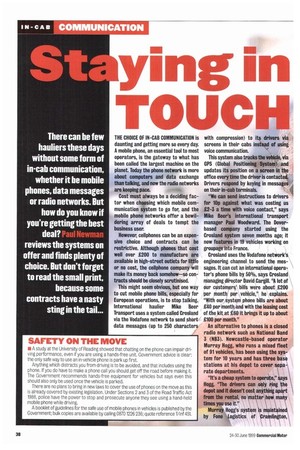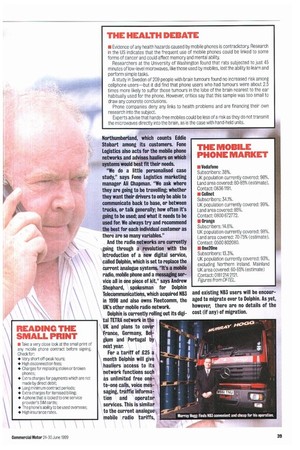There can be few hauliers these days without some form
Page 40

Page 41

If you've noticed an error in this article please click here to report it so we can fix it.
of in-cab communication, whether it be mobile phones, data messages or radio networks. But how do you know if you're getting the best deal? aul Newirmn reviews the systems on offer and finds plenty of choice. But don't forget to read the small print, because some contracts have a nasty sting in the tail... THE CHOICE OF IN-CAB COMMUNICATION is daunting and getting more so every day. A mobile phone, an essential tool to most operators, is the gateway to what has been called the largest machine on the planet. Today the phone network is more about computers and data exchange than talking, and now the radio networks are keeping pace.
Cost must always be a deciding factor when choosing which mobile communication system to go for, and the mobile phone networks offer a bewildering array of deals to tempt the business user.
However, cellphones can be an expensive choice and contracts can be restrictive. Although phones that cost well over £200 to manufacture are available in high-street outlets for little or no cost, the cellphone company will make its money back somehow—so contracts should be closely scrutinised.
This might seem obvious, but one way to cut mobile phone bills, especially for European operations, is to stop talking. International haulier Mike Beer Transport uses a system called Crosland via the Vodafone network to send short data messages (up to 250 characters with compression) to its drivers via screens in their cabs instead of using voice communication.
This system also tracks the vehicle, via BPS (Global Positioning System) and updates its position on a screen in the office every time the driver is contacted. Drivers respond by keying in messages on their in-cab terminals.
"We can send instructions to drivers for 10p against what was costing us £2-3 a time with voice contact," says Mike Beer's international transport manager Paul Woodward. The Doverbased company started using the Crosland system seven months ago; it now features in 19 vehicles working on grou page into France.
Crosland uses the Vodafone network's engineering channel to send the messages. It can cut an international operator's phone bills by 50%, says Crosland managing director David Cargill. "A lot of our customers' bills were about £200 per month per vehicle," he explains. "With our system phone bills are about £40 per month and with the leasing cost of the kit at £60 it brings it up to about 1100 per month."
An alternative to phones is a closed radio network such as National Band 3 (NB3). Newcastle-based operator Murray Hogg, who runs a mixed fleet of 91 vehicles, has been using the system for 10 years and has three base stations at his depot to cover separate departments.
"It's a cheap system to operate," says Hogg. "The drivers can only ring the depot and it doesn't cost anything apart from the rental, no matter how many times you use it."
Murray Hogg's system is maintained by Form Logistics of Cramlington,
Northumberland, which counts Eddie Stobart among its customers. Fone Logistics also acts for the mobile phone networks and advises hauliers on which systems would best fit their needs.
"We do a little personalised case study," says Fone Logistics marketing manager All Chapman. "We ask where they are going to be travelling; whether they want their drivers to only be able to communicate back to base, or between trucks, or talk generally; how often it's going to be used; and what it needs to be used for. We always try and recommend the best for each individual customer as there are so many variables."
And the radio networks are currently going through a revolution with the introduction of a new digital service, called Dolphin, which is set to replace the current analogue systems. "It's a mobile radio, mobile phone and a messaging service all in one piece of kit," says Andrew Shephard, spokesman for Dolphin Telecommunications, which acquired NB3 in 19913 and also owns Fleetcomm, the UK's other mobile radio network.
Dolphin is currently rolling out its digital TETRA network in the UK and plans to cover France, Germany, Belgium and Portugal by next year.
, For a tariff of £25 a \ month Dolphin will give hauliers access to its network functions such as unlimited free oneto-one calls, voice messaging, traffic information and operator services. This is similar to the current analogue mobile radio tariffs, and existing NB3 users will be encouraged to migrate over to Dolphin. As yet, however, there are no details of the cost (if any) of migration.
THE HEALTH DEBATE
• Evidence of any health hazards caused by mobile phones is contradictory. Research in the US indicates that the frequent use of mobile phones could be linked to some forms of cancer and could affect memory and mental ability.
Researchers at the University of Washington found that rats subjected to just 45 minutes of low-level microwaves, like those used by mobiles, lost the ability to learn and perform simple tasks.
A study in Sweden of 209 people with brain tumours found no increased risk among cellphone users—but it did find that phone users who had tumours were about 2.5 times more likely to suffer those tumours in the lobe of the brain nearest to the ear habitually used for the phone. However, critics say that this sample was too small to draw any concrete conclusions.
Phone companies deny any links to health problems and are financing their own research into the subject.
Experts advise that hands-free mobiles could be less of a risk as they do not transmit the microwaves directly into the brain, as is the case with hand-held units.
THE MOBILE PHONE MARKET
• ilodafone Subscribers: 38%. UK population currently covered: 98%. Land area covered: 80-85% (estimate). Contact: 0836 1191.
• Cellnet Subscribers: 34.1%. UK population currently covered: 99%. Land area covered: 85%. Contact: 0800 672772.
• Orange Subscribers: 14.6%. UK population currently covered: 98%. Land area covered: 70-75% (estimate). Contact: 0500 802080.
• One2One Subscribers: 13.3%. UK population currently covered: 93%, excluding Northern Ireland. Mainland UK area covered: 60-65% (estimate) Contact: 0181 214 2121.
Figures from OFTEL.
SAFETY ON THE MOVE
• A study at the University of Reading showed that chatting on the phone can impair driving performance, even if you are using a hands-free unit. Government advice is clear: the only safe way to use an in-vehicle phone is park up first.
Anything which distracts you from driving is to be avoided, and that includes using the phone. If you do have to make a phone call you should get off the road before making it. The Government recommends hands-free equipment for vehicles but says even this should also only be used once the vehicle is parked.
There are no plans to bring in new laws to cover the use of phones on the move as this is already covered by existing legislation. Under Sections 2 and 3 of the Road Traffic Act 1988, police have the power to stop and prosecute anyone they see using a hand-held mobile phone while driving.
A booklet of guidelines for the safe use of mobile phones in vehicles is published by the Government; bulk copies are available by calling 0870 1226 236; quote reference T/irif 451.
READING THE SMALL PRINT
• Take a very close look at the small print of any mobile phone contract before signing. Check for; • Very short off-peak hours; • High disconnection fees; • Charges for replacing stolen or broken phones; • Extra charges for payments which are not made by direct debit; • Long minimum contract periods; • Extra charges for itemised billing; • A phone that is locked to one service provider's SIM cards; • The phone's ability to be used overseas; • High insurance rates.




















































































































